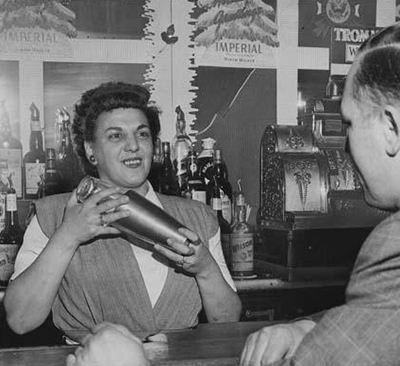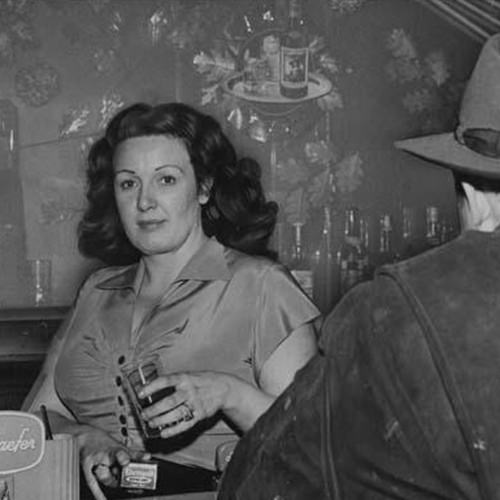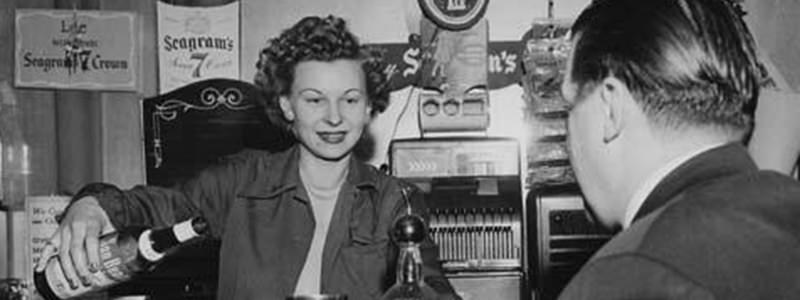Patriotism has taken many forms throughout the years. During World War II, a generation of women saluted America by keeping the economy functioning during a time of battle. These awesome ladies famously traded their aprons and housedresses for bandanas and coveralls, answering the government’s campaign to fill thousands of jobs left by drafted men. While Rosie the Riveter and skirted baseball players have become this proto-feminist era’s lasting icons, mechanics and professional athletes weren’t the only gigs left vacant by the war. During this time of extreme turmoil, some of the nation’s trustiest places were left vacant: the barrooms. These establishments found themselves without men behind the taps. What was an American craving a drink to do?
Enter “Bessie the Bartender” – the female bartending revolution.
Let’s back up. By the late 1930’s, thirteen insufferable years of Prohibition had finally come to a close, and taprooms resumed their place as America’s man caves. These were the kind of joints where a guy could down a cold one, belt out some Irish ballads and catch up with world news and neighborhood gossip alike. Unsurprisingly, barhopping was largely a boys-only brotherhood. While some saloons allowed women patrons, occasionally reserving a sidelined seated area or even a separate back door for thirsty ladies, hardly any bar in the country took on female barkeeps. These celebrated dens of vice cited a variety of outdated reasons for keeping the fairer sex at bay, ranging from the risk of sexual temptation and ruin to a woman’s presumed inability to mix a drink correctly. As The Troy Record once wrote, “Who wants the hand that rocks the cradle mixing whisky sours?”

Yet, after the bombing of Pearl Harbor, necessity changed everything and an eager fleet of lady bartenders from California to New York City slipped comfortably behind the mahogany. In 1939, a group of female Brooklyn tapsters organized the Bar Maids Local 101 in anticipation of post-war fallout. These courageous women managed to break ground within the well-guarded liquor industry by simultaneously conceding to a few pesky social norms. For instance, the ladies vowed not to work past midnight and were prohibited from giving out their last names so as not to tempt inquisitive men. By the end of the 1940s, thanks in part to the Local’s success, Brooklyn alone counted over 100 barmaids working in 75 bars, their positions ranging from down and dirty whisky slingers and grog hawkers to refined restaurant sommeliers. This was a remarkable shift when compared to a 1895 census listing just 147 women of nearly 56,000 professional bartenders nationwide. At a time when raising a pint in the comfort of friends provided a key escape from the horrors and uncertainties of a war-stricken society, women were truly stepping up, keeping America’s beloved barrooms in business.
And then, just when things seemed to be leveling out between the booze-savvy, the inevitable happened: the fellas heroically returned from overseas, expecting to find both their jobs, and their wives, exactly as they’d left them. Many American women complied, though some held tight to their jiggers and shakers, refusing to give up the lucrative and respected profession that had treated them so kindly throughout their years of service. As a wartime barmaid named Lorretta (pictured) told the Brooklyn Eagle, “A woman has to make a living, and what’s wrong with bartending? During the war it was patriotic for us to work.”

Frustratingly, legal motions backed by male-only bartending unions popped up around the country as vets battled to reclaim their posts. In 1945, Michigan passed a law making it illegal for women to mix drinks unless they were directly related to the bar’s male proprietor. Three years later, several scorned Michigan women challenged the law, taking the fight all the way to the US Supreme Court, where Justice Felix Frankfurter upheld the state’s right to barroom segregation by heeding to the constitutional importance of local legislature. Judge Frankfurter’s landmark ruling squashed the development of similar challenges in a handful of likeminded states and more than half of the country’s Bessies were forced to turn in their bar mops by the early 1960’s.
It wasn’t until the mid-70’s that a subsequent Supreme Court decision barring workforce discrimination finally welcomed women back across the tavern’s threshold — and back they came. According to a Wall Street Journal article outlining the history of female barkeeps, the demand for women behind the bar solidified when a slew of Holiday Inns realized that bar tabs skyrocketed in the presence of a comely lady mixologist. And by the early 1980’s, whether it was through hard work, determination, creativity, skill or even a bit of flirting, Bessie and her fellow barmaids had at last broken through the sudsiest of glass ceilings, cementing themselves as fixtures of the modern barroom.
Additional sources: America Walks Into A Bar
All images courtesy of The Brooklyn Public Library

